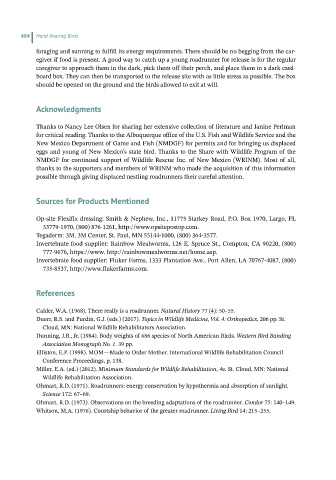Page 488 - Hand rearing birds second
P. 488
484 Hand-Rearing Birds
foraging and sunning to fulfill its energy requirements. There should be no begging from the car-
egiver if food is present. A good way to catch up a young roadrunner for release is for the regular
caregiver to approach them in the dark, pick them off their perch, and place them in a dark card-
board box. They can then be transported to the release site with as little stress as possible. The box
should be opened on the ground and the birds allowed to exit at will.
Acknowledgments
Thanks to Nancy Lee Olsen for sharing her extensive collection of literature and Janine Perlman
for critical reading. Thanks to the Albuquerque office of the U.S. Fish and Wildlife Service and the
New Mexico Department of Game and Fish (NMDGF) for permits and for bringing us displaced
eggs and young of New Mexico’s state bird. Thanks to the Share with Wildlife Program of the
NMDGF for continued support of Wildlife Rescue Inc. of New Mexico (WRINM). Most of all,
thanks to the supporters and members of WRINM who made the acquisition of this information
possible through giving displaced nestling roadrunners their careful attention.
Sourcesfor ProductsMentioned
Op‐site Flexifix dressing: Smith & Nephew, Inc., 11775 Starkey Road, P.O. Box 1970, Largo, FL
33779‐1970, (800) 876‐1261, http://www.opsitepostop.com.
Tegaderm: 3M, 3M Center, St. Paul, MN 55144‐1000, (800) 364‐3577.
Invertebrate food supplier: Rainbow Mealworms, 126 E. Spruce St., Compton, CA 90220, (800)
777‐9676, https://www. http://rainbowmealworms.net/home.asp.
Invertebrate food supplier: Fluker Farms, 1333 Plantation Ave., Port Allen, LA 70767‐4087, (800)
735‐8537, http://www.flukerfarms.com.
References
Calder, W.A. (1968). There really is a roadrunner. Natural History 77 (4): 50–55.
Duerr, R.S. and Purdin, G.J. (eds.) (2017). Topics in Wildlife Medicine, Vol. 4: Orthopedics, 206 pp. St.
Cloud, MN: National Wildlife Rehabilitators Association.
Dunning, J.B., Jr. (1984). Body weights of 686 species of North American Birds. Western Bird Banding
Association Monograph No. 1. 39 pp.
Elliston, E.P. (1998). MOM—Made to Order Mother. International Wildlife Rehabilitation Council
Conference Proceedings, p. 138.
Miller, E.A. (ed.) (2012). Minimum Standards for Wildlife Rehabilitation, 4e. St. Cloud, MN: National
Wildlife Rehabilitation Association.
Ohmart, R.D. (1971). Roadrunners: energy conservation by hypothermia and absorption of sunlight.
Science 172: 67–69.
Ohmart, R.D. (1973). Observations on the breeding adaptations of the roadrunner. Condor 75: 140–149.
Whitson, M.A. (1976). Courtship behavior of the greater roadrunner. Living Bird 14: 215–255.

